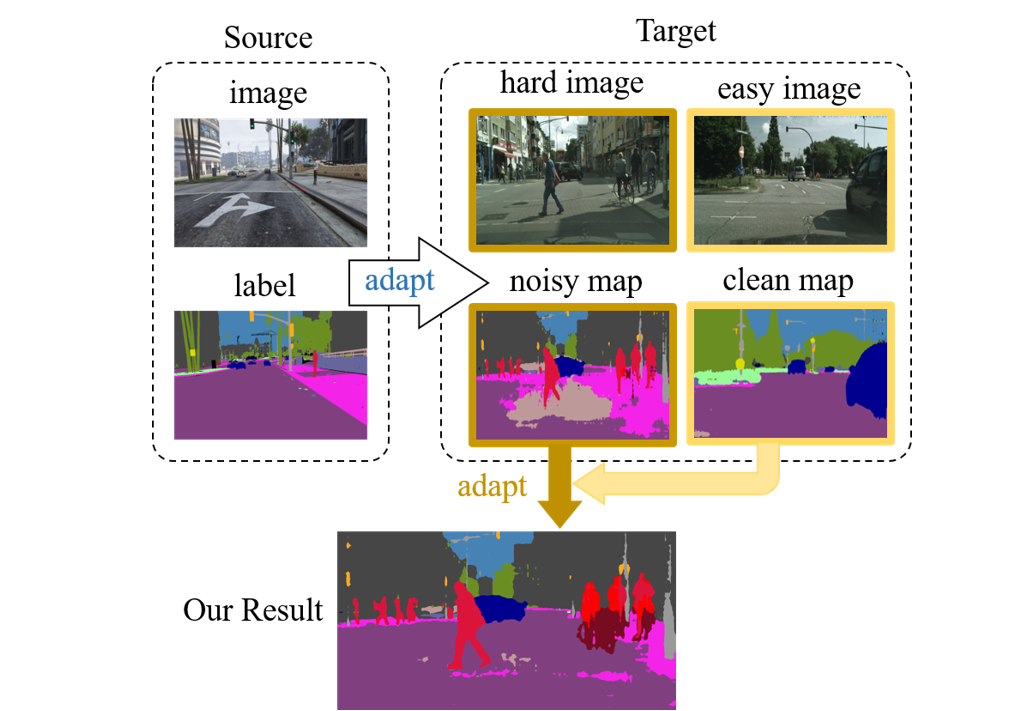[Project Page] [Presentation] [DemoVideo] [讲演视频] [效果演示]
Unsupervised Intra-domain Adaptation for Semantic Segmentation through Self-Supervision
Fei Pan, Inkyu Shin, Francois Rameau, Seokju Lee, In So Kweon
KAIST, Korea
IEEE Conference on Computer Vision and Pattern Recoginition (CVPR), 2020 (Oral)
If you find this paper or code useful for your research, please cite our paper:
@InProceedings{pan2020unsupervised,
title = {Unsupervised Intra-domain Adaptation for Semantic Segmentation through Self-Supervision},
author = {Pan, Fei and Shin, Inkyu and Rameau, Francois and Lee, Seokju and Kweon, In So},
booktitle = {IEEE Conference on Computer Vision and Pattern Recoginition (CVPR)},
year = {2020}
}
Convolutional neural network-based approaches have achieved remarkable progress in semantic segmentation. However, these approaches heavily rely on annotated data which are labor intensive. To cope with this limitation, automatically annotated data generated from graphic engines are used to train segmentation models. However, the models trained from synthetic data are difficult to transfer to real images. To tackle this issue, previous works have considered directly adapting models from the source data to the unlabeled target data (to reduce the inter-domain gap). Nonetheless, these techniques do not consider the large distribution gap among the target data itself (intra-domain gap). In this work, we propose a two-step self-supervised domain adaptation approach to minimize the inter-domain and intra-domain gap together. First, we conduct the inter-domain adaptation of the model; from this adaptation, we separate the target domain into an easy and hard split using an entropy-based ranking function. Finally, to decrease the intra-domain gap, we propose to employ a self-supervised adaptation technique from the easy to the hard split. Experimental results on numerous benchmark datasets highlight the effectiveness of our method against existing state-of-the-art approaches.
This work is supported by BOSCH.
This repo is heavily borrowed from ADVENT, AdaptSegNet, and Pytorch-Deeplab.
- Python 3.7
- Pytorch >= 0.4.1
- CUDA 9.0 or higher
- Clone the repo:
$ git clone https://github.com/feipanir/IntraDA.git
$ cd IntraDA- Install OpenCV if you don't already have it:
$ conda install -c menpo opencvif it doesn't work, please try to use conda pip
$ which pip # should be $HOME/anaconda3/bin/pip, be sure to use conda pip
$ pip install opencv-python - Install ADVENT submodule and the dependices using pip: if you use
$ pip install -e <root_dir/ADVENT>With this, you can edit the ADVENT code on the fly and import function and classes of ADVENT in other project as well.
We follow set-ups from ADVENT. The datasets are put into <root_dir>/ADVENT/data. Symlinks to hook the ADVENT codebase to the dataset is recommended. An alternative option is to explicitlly specify the parameters DATA_DIRECTORY_SOURCE and DATA_DIRECTORY_TARGET in YML configuration files.
GTA5: Please follow the instructions here to download images and semantic segmentation annotations. The GTA5 dataset directory should have this basic structure:
<root_dir>/ADVENT/data/GTA5/ % GTA dataset root
<root_dir>/ADVENT/data/GTA5/images/ % GTA images
<root_dir>/ADVENT/data/GTA5/labels/ % Semantic segmentation labels
...Cityscapes: Please follow the instructions in Cityscape to download the images and validation ground-truths. The Cityscapes dataset directory should have this basic structure:
<root_dir>/ADVENT/data/Cityscapes/ % Cityscapes dataset root
<root_dir>/ADVENT/data/Cityscapes/leftImg8bit % Cityscapes images
<root_dir>/ADVENT/data/Cityscapes/leftImg8bit/val
<root_dir>/ADVENT/data/Cityscapes/gtFine % Semantic segmentation labels
<root_dir>/ADVENT/data/Cityscapes/gtFine/val
...Please download the pretrained model and put in <root_dir>/ADVENT/pretrained_models. And please download the evaluation models for evaluation process. Moreover, the trained AdvEnt model is shared here.
For evaluation, execute:
$ cd <root_dir>/intrada
$ python test.py --cfg intrada_trained.yml
$ python test.py --cfg intrada_trained_withnorm.yml # test on models trained wih entropy normalizationOur training environment is based on pytorch 0.4.1 and CUDA 9.0. To reach to the comparable performance you may need to train a few times.
By default, logs and snapshots are stored in <root_dir>/experiments with this structure:
<root_dir>/ADVENT/experiments/logs
<root_dir>/ADVENT/experiments/snapshotsStep 1. Conduct inter-domain adaptation by training ADVENT:
$ cd <root_dir>/ADVENT/advent/scripts
$ python train.py --cfg ./config/advent.yml
$ python train.py --cfg ./config/advent.yml --tensorboard % using tensorboardAfter inter-domain training, it is needed to get best IoU iteration by runing:
$ cd <root_dir>/ADVENT/advent/scripts
$ python test.py --cfg ./config/advent.ymlThe best IoU iteration BEST_ID will be a parameter to step 2.
Step 2. Entropy-based ranking to split Cityscapes training set into easy split and hard split:
$ cd <root_dir>/entropy_rank
$ python entropy.py --best_iter BEST_ID --normalize False --lambda1 0.67 You will see the pseudo labels generated in color_masks, the easy split file names in easy_split.txt, and the hard split file names in hard_split.txt.
Step 3. Conduct intra-domain adaptation by runing:
$ cd <root_dir>/intrada
$ python train.py --cfg ./intrada.yml
$ python train.py --cfg ./intrada.yml --tensorboard % using tensorboardTo test the performance from intrada, run:
$ cd <root_dir>/intrada
$ python test.py --cfg ./intrada.yml[1] Tsai, Yi-Hsuan, et al. "Learning to adapt structured output space for semantic segmentation." Proceedings of the IEEE Conference on Computer Vision and Pattern Recognition. 2018.
[2] Vu, Tuan-Hung, et al. "Advent: Adversarial entropy minimization for domain adaptation in semantic segmentation." Proceedings of the IEEE Conference on Computer Vision and Pattern Recognition. 2019.
IntraDA is released under MIT License.



